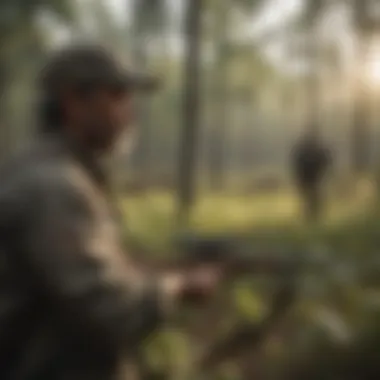Discovering Alabama's Public Hunting Land Opportunities


Intro
Alabama offers a unique landscape for hunters, showcasing diverse habitats rich in wildlife. Understanding the dynamics of public hunting land is crucial for both seasoned hunters and newcomers in the field. The state's public lands offer opportunities to engage in hunting, while also playing an integral role in wildlife management and conservation efforts. This guide highlights the essential elements related to public hunting in Alabama, including regulations, best practices, and sustainability initiatives.
Understanding Forestry Practices
Exploring forestry practices in Alabama lays a foundation for comprehending the relationship between these practices and public hunting lands. Effective forestry practices not only enhance the health of wildlife habitats but also contribute to sustainable wildlife populations.
Types of Forestry Practices
Forestry practices in Alabama can be broadly categorized into several types:
- Selective Cutting: This involves removing specific trees while leaving others standing. It helps maintain biodiversity in the forest.
- Clear-Cutting: This method harvests all trees in a designated area. While this can regenerate new growth, it can also lead to habitat loss and soil erosion if not managed properly.
- Shelterwood Cutting: This develops a new generation of trees under the protection of older trees. It allows for a gradual enhancement of wildlife habitats.
Greater emphasis on sustainable forestry ensures that hunters benefit from rich ecosystems that support diverse game species.
Historical Context
Historically, Alabama's forestry practices have undergone significant changes. Early logging was often unsustainable, leading to substantial deforestation and soil degradation. In response, regulatory frameworks evolved to enhance the management of public land, ensuring that hunting and other recreational activities could continue sustainably. Over time, the focus has shifted to more responsible ecological practices that benefit both wildlife and public access.
Principles of Woodland Stewardship
Adopting principles of woodland stewardship is essential for promoting sustainable hunting practices in Alabama. This includes implementing conservation techniques and effective resource management strategies that resonate with both hunters and conservationists.
Conservation Techniques
Conservation techniques relevant to public hunting lands include:
- Habitat Restoration: Involves re-establishing native plants and rehabilitating ecosystems.
- Invasive Species Management: This focuses on controlling non-native species that threaten local biodiversity.
- Wildlife Corridors: Creating paths for wildlife to move safely between habitats, enhancing genetic diversity among species.
Employing these techniques can greatly improve the ecological integrity of hunting lands.
Managing Forest Resources
Efficient management of forest resources directly impacts hunting. Strategies such as maintaining healthy forest compositions, regulating hunting seasons, and enforcing harvest limits are crucial. Engaging the community in resource management fosters a shared commitment to conservation and responsible hunting practices.
Sustainable Forest Management
The concept of sustainable forest management (SFM) is paramount in balancing economic viability with ecological health. This approach ensures that the needs of the present do not compromise future generations' ability to enjoy hunting.
Certification Standards
Various organizations, such as the Forest Stewardship Council (FSC), have established certification standards that promote sustainability in forestry. These standards help hunters and land managers identify responsibly managed resources, fostering greater trust and collaboration among stakeholders.
Economic Benefits of Sustainability
Sustainable practices also yield economic benefits. By maintaining healthy forests, Alabama can attract tourism related to hunting while ensuring long-term viability of timber resources. This interconnectedness between ecological health and economic stability highlights the importance of responsible forest management.
"Sustainable forest management is not just about conservation; it's the key to balanced ecological and economic prosperity in Alabama's public lands."
Prolusion to Public Hunting Land in Alabama
Public hunting lands in Alabama play a crucial role in wildlife management and conservation. They provide opportunities not only for hunters but also for those interested in outdoor recreation and education. These areas support biodiversity, protect habitats, and promote sustainable use of natural resources. Each public hunting land type, from wildlife management areas to national forests, contributes to preserving Alabama's rich ecological tapestry while offering societal benefits.
Definition and Importance
Public hunting land can be defined as areas managed by state and federal agencies where hunting is allowed. These lands typically include wildlife management areas, national forests, and state parks. The importance of these spaces cannot be overstated. They serve multiple purposes: facilitating hunting, conserving wildlife populations, and providing habitats for diverse species. Moreover, these lands serve as educational platforms for inexperienced hunters, offering resources and guidelines to ensure responsible hunting practices.


"Public hunting lands are vital for both ecological balance and for maintaining cultural hunting traditions in Alabama."
The distribution and accessibility of such lands enhance community engagement and contribute to local economies. They support not only hunters but also wildlife enthusiasts, bird watchers, and nature lovers. This collective enjoyment fosters a greater appreciation of the environment, underscoring the significance of public hunting lands.
Historical Context
The historical context of public hunting land in Alabama reveals a long-standing relationship between the state's residents and its natural resources. In the early 20th century, hunting was not merely a recreational activity; it was a means of sustenance for many families. Over time, wildlife populations declined due to overhunting and habitat destruction, prompting collective action for conservation.
Consequently, the establishment of wildlife management areas in the mid-20th century marked a significant turning point. This period saw the creation of regulations aimed at protecting species and their habitats while allowing regulated hunting. The collaboration between state agencies and local communities has evolved, leading to the modern understanding and management of public hunting lands. Alabama’s commitment to sustainable practices continues to stem from this historical awareness, contributing to the richness of the state's hunting culture today.
Types of Public Hunting Lands
Understanding the types of public hunting lands in Alabama is crucial for hunters aiming to optimize their experience. These lands offer a diverse range of environments, each designed to facilitate specific recreational and conservation activities. Public hunting lands serve not only as venues for hunting but also as vital habitats for wildlife. Knowing the distinct characteristics of these lands can help hunters make informed decisions and promote sustainable practices.
Wildlife Management Areas
Wildlife Management Areas (WMAs) in Alabama are essential for both hunting and conservation. These areas are specifically managed to support wildlife populations and to enhance hunting experiences. The Alabama Department of Conservation and Natural Resources oversees these lands, ensuring they meet the dual goals of providing hunting opportunities while promoting wildlife health.
Typically, WMAs offer access to various game species, including deer, turkey, and small game. Each WMA has its own regulations and guidelines, making it essential for hunters to familiarize themselves with these rules before venturing out. The habitat within WMAs often includes a mix of woodlands, wetlands, and grasslands, fostering rich ecosystems conducive to diverse wildlife.
"Wildlife Management Areas are more than just places to hunt; they are crucial for maintaining biodiversity and ensuring healthy populations of game species."
National Forests
Alabama's National Forests represent another significant type of public hunting land. The largest among them includes the Talladega National Forest and the Bankhead National Forest. These expansive natural areas provide ample opportunities for various types of hunting, including deer and wild turkey.
National forests often afford hunters the chance to explore remote and less trafficked areas. The diverse topography and differing habitats within these forests contribute to healthy wildlife populations. However, hunters should note that national forests may have specific rules regarding certain hunting methods or seasons, emphasizing the need for awareness and compliance.
State Parks
State Parks in Alabama play a unique role in public hunting. Although not all state parks permit hunting, several designated areas do allow it in accordance with state regulations. The integration of recreational activities, such as hiking and fishing alongside hunting, distinguishes these lands from pure hunting areas.
Hunters should research which state parks offer hunting as a permitted activity and the specific seasons and rules that apply. The natural beauty and accessibility of state parks make them an attractive option for hunters seeking a multi-faceted outdoor experience.
Refuges and Sanctuaries
Refuges and sanctuaries provide critical habitats that serve to protect wildlife during sensitive periods, such as migration or breeding. In Alabama, these lands are often designated for the conservation of specific species and ecosystems. Some areas may allow limited hunting, depending on the regulations set by organizations like the U.S. Fish and Wildlife Service.
Hunting in these areas can be regulated closely to ensure that hunting activities do not disrupt the ecological balance. It is essential for hunters to respect these regulations, as they play a vital role in maintaining healthy populations and habitats. Refuges and sanctuaries contribute significantly to Alabama’s ecosystem and should be regarded as integral parts of the state's natural resources.
Regulations Governing Public Hunting
Understanding the regulations governing public hunting in Alabama is crucial for all hunters. These rules ensure sustainable wildlife management, protect natural habitats, and maintain safety in hunting activities. Compliance with these regulations is not just a matter of legality; it reflects an ethical responsibility that hunters must uphold to safeguard the environment and wildlife populations.
Licensing Requirements
In Alabama, obtaining a hunting license is a necessary step for any individual wishing to hunt on public lands. The state mandates that hunters participate in the licensing program operated by the Alabama Department of Conservation and Natural Resources (ADCNR). Various licenses are available, including a standard hunting license, a wildlife management license, and a federal migratory bird stamp for waterfowl hunters.
To qualify for a license, hunters must prove their identity and residency. Valid identification includes state-issued IDs, social security numbers, and proof of domicile. Additionally, individuals born after 1976 must complete a hunter education course before applying for a license. This requirement emphasizes safety and responsibility, two core values in hunting culture.
Seasonal Regulations
Seasonal regulations dictate specific time frames during which hunting is allowed for various game species. These regulations are critical as they align with wildlife breeding cycles and seasonal migration patterns. Each year, the ADCNR publishes a detailed hunting guide outlining open and closed seasons for different species such as deer, turkey, and small game.
For example, the general deer hunting season typically runs from mid-October to early February. However, it is essential for hunters to remain informed about any changes to these dates or special hunts designated for young hunters or those with disabilities. Adhering to these regulations helps maintain population stability and ensures that hunting does not occur during critical periods for wildlife.
Bag Limits and Restrictions


Bag limits are established to regulate the number of animals that a hunter can harvest in a single day or season. These limits vary by species and are influenced by population assessments conducted by wildlife biologists. For instance, Alabama may allow a bag limit of two antlered deer per day but may place restrictions on antler size during specific seasons.
Hunters must also be aware of restrictions regarding species protection. Certain animals, such as threatened or endangered species, are strictly protected under Alabama law. Violating these bag limits or restrictions can result in severe penalties, including fines or loss of hunting privileges.
"Following regulations is not just about obeying laws; it is about ensuring the legacy of responsible hunting for future generations."
By adhering to licensing requirements, seasonal regulations, and bag limits, hunters contribute to the sustainable management of Alabama's rich wildlife resources. The careful observation of these regulations not only enhances the hunting experience but also fosters a healthier ecosystem, balancing human recreation with nature's needs.
Sustainable Hunting Practices
Sustainable hunting practices are essential for maintaining the ecological balance in Alabama's public hunting lands. They not only ensure the preservation of wildlife populations but also contribute to the overall health of ecosystems. Responsible hunting is a cornerstone of conservation efforts, allowing hunters to engage with nature while safeguarding its resources for future generations.
Ethical Considerations
Ethical hunting goes beyond legality; it embodies a philosophy of stewardship and respect for wildlife. Hunters must consider the impact of their actions, aiming for humane practices and habitat preservation. Always follow the "fair chase" concept, which emphasizes the ethical pursuit of game. This involves not exploiting the animal's vulnerabilities or using unfair techniques.
Consider the following ethical hunting practices:
- Adhering to local hunting regulations and guidelines.
- Avoiding overharvesting to maintain healthy populations.
- Respecting landowners' rights and private property.
- Reporting poaching or unethical practices to authorities.
Hunters should also acknowledge their role in conservation. By participating in regulated hunts, they help manage animal populations, thus promoting healthier ecosystems. Supporting local wildlife organizations can further enhance sustainable practices.
Conservation Efforts
Conservation is vital for preserving Alabama's rich biodiversity. Sustainable hunting practices support conservation efforts in various ways. For instance, hunting licenses and fees often fund wildlife management programs that protect habitats and species. These funds can help restore ecosystems degraded by human activity.
Additionally, successful conservation requires active participation from hunters. Here are key methods that contribute to conservation efforts:
- Wildlife Surveys: Data collected by hunters assists wildlife managers in understanding population dynamics and health.
- Habitat Preservation: Hunters often participate in habitat improvement projects, like planting food plots or removing invasive species.
- Education: Responsible hunters serve as role models and educators, sharing knowledge about conservation with less experienced individuals.
- Funding: Many organizations rely on hunters' contributions to finance conservation initiatives that benefit overall wildlife management.
"Sustainable hunting is not just a hobby; it is an invaluable investment in the future of our wildlife and natural spaces."
It is imperative for hunters in Alabama to embrace sustainable practices not only for the health of their sport but also for the environment. By aligning their activities with conservation goals, they can ensure that future generations will enjoy access to these public lands with their rich wildlife heritage intact.
Wildlife Species and Habitats
Understanding wildlife species and their habitats is crucial for anyone interested in public hunting in Alabama. This section delves into the diverse fauna in the region and the specific ecological requirements that support them. By comprehending these elements, hunters can enhance their experiences while promoting conservation efforts, thus ensuring sustainable practices throughout the hunting community.
Wildlife species not only play vital roles in their ecosystems but also contribute significantly to the cultural and recreational aspects of hunting. Recognizing the dynamics between species and their environments allows for more informed decisions regarding hunting practices. Additionally, appreciating the variety of habitats improves the hunter's ability to locate and sustain populations of game species.
Maintaining healthy wildlife populations is interconnected with habitat preservation. Given the impact of human activities, understanding these connections fosters better stewardship practices among hunters, ensuring that Alabama's rich biodiversity continues to thrive.
Common Game Species in Alabama
Alabama offers a variety of game species that are popular among hunters. Some of the common species include:
- White-tailed Deer: This species is one of the most sought after in Alabama. They are abundant, which makes them a prime target during hunting seasons.
- Wild Turkey: Known for their challenging hunts, wild turkeys draw many hunters. Their unique vocalizations and behaviors add to the excitement.
- Dove: Dove hunting offers a different experience, requiring quick reflexes and strategic location. They are plentiful in open fields during migration periods.
- Quail: This classic game bird is often hunted in coveys, requiring a keen eye and good dogs.
- Bears: In certain areas, black bears are becoming more common and present a unique challenge for hunters due to their size and strength.
Each species has its own unique characteristics and behaviors, requiring different hunting strategies and tactics. Familiarity with these game species ensures hunters can plan effectively and ethically.
Habitat Requirements
Habitats serve as the lifeline for wildlife, providing food, shelter, and breeding grounds. Different species require specific habitat types to thrive. In Alabama, diverse ecosystems, such as woodlands, wetlands, and grasslands, support various wildlife. Here are key habitat requirements for common game species:
- White-tailed Deer: They prefer mixed forests and agricultural areas where food sources are abundant. They need a combination of foraging areas and dense cover for shelter.
- Wild Turkey: Turkeys thrive in open hardwood forests with nearby fields. They require access to water and timbered areas for nesting.
- Dove: As creatures of the open fields, doves require access to seed sources. They are often found near agricultural fields and weedy areas.
- Quail: Early successional habitats with a mix of grasses and shrubs are crucial for quail survival as they need cover and food resources.
- Bears: Black bears prefer forested areas with a rich understory for foraging. They rely on seasonal food sources such as berries and nuts.
Understanding the habitat requirements for these species not only informs hunting strategies but also emphasizes the importance of conservation efforts. By protecting and restoring habitats, hunters can contribute to healthier ecosystems that benefit all wildlife.


"Conservation is a state of harmony between men and land." - Aldo Leopold
Navigating Alabama's Public Lands
Navigating Alabama's public lands is crucial for hunters and outdoor enthusiasts who wish to make the most of their experiences. Understanding how to approach these lands can greatly enhance the hunting experience, providing both safety and an improved chance of success. Knowledge about maps, resources, and access points can help one navigate the complex terrain and find suitable hunting locations efficiently.
This section addresses specific aspects such as available maps, useful resources, and the various options for camping and lodging in proximity to hunting sites. Knowing where to locate these facilities can provide significant advantages in planning a hunting trip, ensuring that hunters are equipped to meet their needs effectively.
Maps and Resources
Maps are an essential tool for anyone venturing onto Alabama's public hunting lands. They provide critical information regarding land boundaries, terrain features, and the locations of species habitats. Various resources exist for hunters, both online and offline, to help them plan their trips.
Here are some recommended types of resources to consider:
- Official State Websites: The Alabama Department of Conservation and Natural Resources maintains up-to-date maps and data about public hunting lands. These sites often offer downloadable PDFs and interactive maps.
- Local Wildlife Management Area Guides: These guides outline specific regulations and wildlife populations in designated areas, assisting hunters in selecting the right spots.
- Mobile Apps: Applications like onX Hunt provide real-time GPS tracking and land ownership data, allowing for informed decision-making while in the field.
- Printed Topographic Maps: These maps detail topographical features and can be sourced from outdoor retailers or local offices.
"Having the proper maps and resources can significantly influence a hunter's ability to navigate safely and successfully on public lands."
To maximize your hunting experience, familiarize yourself with the resources available and plan your routes ahead of time.
Camping and Lodging Options
Finding suitable camping and lodging options is a key consideration for those wishing to spend extended periods on Alabama's public hunting lands. There are various accommodations available, depending on your needs and preferences.
- Campsites within Wildlife Management Areas: Many WMAs offer established campsites complete with necessary amenities such as restrooms and picnic tables. Reservations usually are recommended during peak hunting seasons.
- National Forest Camping: The Talladega National Forest and the Bankhead National Forest are popular sites for camping. Spots can vary from primitive sites with no facilities to developed sites that may offer some amenities.
- Private Cabins and Lodges: For a more comfortable stay, consider renting a cabin or lodge near hunting lands. Websites like Airbnb can be useful for finding unique properties.
- Local Motels and Hotels: In towns near hunting areas, motels and hotels can provide convenient lodging for those who prefer not to camp.
Researching the various accommodations ensures that you choose a suitable option closest to your target hunting area, maximizing your time and resources.
Challenges and Future Trends
The examination of challenges and future trends in public hunting land management in Alabama is critical. These issues shape the hunting experience and influence how wildlife is conserved. Understanding them allows hunters and stakeholders to adapt, ensuring responsible use of natural resources while maintaining ecological integrity. The landscape is changing, and awareness of these shifts is essential for sustainability.
Impact of Climate Change
Climate change poses significant threats to hunting and wildlife populations in Alabama. Variability in weather patterns can alter habitats, making it essential for hunters to stay informed and flexible. Warmer winters, irregular precipitation, and shifting foliage can affect species movements and reproductive cycles.
- Habitat Loss: Increased temperatures may lead to habitat degradation. Some native species might struggle to adapt, possibly leading to declining populations.
- Changing Migration Patterns: Game species may migrate earlier or later than usual. This unpredictability impacts hunting seasons and success rates.
Hunting regulations may need to adjust based on these environmental changes. This calls for continuous assessment and re-evaluation to support both wildlife conservation and hunter engagement.
"Adaptive management strategies are necessary to address the ongoing and future impacts of climate change on Alabama's wildlife."
Technological Advancements
Technological advancements offer both opportunities and challenges for public hunting in Alabama. New tools enhance the hunting experience but also require hunters to stay updated with effective practices and standards.
- GPS and Mapping Technologies: These innovations help hunters navigate public lands more effectively. Understanding terrain and wildlife habitats becomes more accurate.
- Wildlife Monitoring: Drones and camera traps allow for better research on wildlife patterns and populations. Such data supports informed decision-making related to hunting and conservation efforts.
- Sustainable Practices: Technology can promote sustainable hunting. Apps provide up-to-date information on regulations, seasonal changes, and best practices for wildlife management.
As these advancements emerge, ethical considerations must also be addressed. The balance between technology and traditional hunting practices is crucial.
The future of public hunting land management in Alabama will likely depend on integrating these technological solutions while considering their ecological impact.
Ending
The conclusion serves as a critical element in understanding public hunting land in Alabama. It synthesizes the information presented earlier, reinforcing the significance of these lands not only for recreational activities but also for wildlife conservation and management. Alabama's diverse ecosystem, cultivated through such public lands, offers an invaluable resource for both novice and experienced hunters. These ecosystems are essential for maintaining biodiversity and supporting various species.
Summation of Key Points
- Diverse Types of Public Lands: Alabama boasts numerous types of public hunting areas, including wildlife management areas, national forests, state parks, and wildlife refuges. Each plays a unique role in supporting hunting and conservation efforts.
- Comprehensive Regulations: Understanding hunting regulations, such as licensing requirements and bag limits, is vital for legal hunting and for conservation. Hunters must be aware of seasonal regulations to adhere to laws and practice sustainable hunting.
- Sustainable Practices: The article emphasizes ethical considerations and conservation efforts to ensure the long-term health of wildlife populations. Responsible hunting contributes to ecosystem balance while allowing for recreational use.
- Navigational Resources: Access to maps and camping options enhances the hunting experience, providing hunters with essential tools for exploration.
- Challenges and Trends: Ongoing challenges, including climate change and technological advancements, were discussed to underline their impacts on hunting practices and wildlife habitats in Alabama.
Encouragement for Responsible Use
The importance of responsible use of public hunting lands cannot be overstated. Not only does ethical hunting contribute to sustainability, but it also preserves ecosystems for future generations. Hunters are urged to:
- Educate Themselves: Understand local regulations and wildlife needs to engage in practices that promote conservation.
- Limit Their Impact: Practice minimal interference with habitats and focus on taking only what is necessary.
- Participate in Conservation Efforts: Engage in programs that help restore and maintain habitats, enhancing the hunting experience and ecological integrity.
By adopting responsible practices, hunters can ensure that Alabama's public hunting lands remain a vibrantly functioning part of the larger ecosystem, balancing the needs of wildlife with recreational activities.







